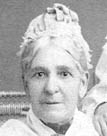 Eliza
Minogue
Eliza
MinogueAccording to Des Sykes, each day there was Mass in Wentworth, Eliza would walk to Wentworth dressed in a black bonnet and black bombazine clothes, up till the age of 80 or so.
The Minogues adopted two children. One, Christina Power (1879 - 1927), born in Victoria, was, according to one theory, the illegitimate daughter of Herbert Power, who had a large property ('Polia') north east of Wentworth. She apparently never knew she was adopted, and used the name Christina Minogue until she was married (thereafter Christina Wilkes). Jean Roper (nee Loomes) remembers that Christina painted pictures and had a 'good eye' for floral arrangement.
The other adopted child was Richard Lowry, who went on to become manager of Bowrings in Mildura; he had no children.
William Minogue died in 1918 from drowning, crossing some horses at the site of the current Wentworth bridge. His burial place is unknown.
Following the gold rushes, Australia enjoyed a pastoral boom, and had one of the highest standards of living in the world. Wentworth grew rapidly; In 1871 St. Francis' Church (still standing today) was built, in 1872 John Leary built the Commercial Hotel (still standing, but maybe not for long), a bank was established, a turf club was formed, and the brick gaol begun. In 1880 the race track was built on its present site, with a grandstand (subsequenty named the EJ. Sykes pavilion, but demolished several years ago), and in 1881 the gaol was finished. In 1888 Mildura was first settled, and a railway line built to Yelta, on the Victoria side of the Murray river. Despite many official pleas, a bridge for the railway was never built into New South Wales. Consequently, rail transport, which replaced the paddle steamer, was to and from Mildura, making Mildura, in the next fifty years, into a more important centre than Wentworth.

Christina - adopted daughter of Minogues